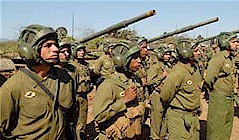
Cuba bolsters its national defense through Operation Bastion 2009. The country has survived and prospered despite nearly five decades of an illegal blockade by US imperialism., a photo by Pan-African News Wire File Photos on Flickr.
Havana. May 23, 2011
METEORO-2011
Cuba focuses on training to protect human lives and property
IN these hard times, when nature is asserting its power without differentiating between rich and poor countries, here in Cuba we have drought, while other peoples face floods, volcanic eruptions, earthquakes, hurricanes, tornadoes and burning jungles, as if the planet were settling accounts. Cuba is preparing, as it does every year before the hurricane season (June 1 – November 1), with the traditional training and practice exercise Meteoro 2011, in order to strengthen organization and the people’s ability to respond to natural disasters.
The Civil Defense General Staff, which is responsible for the activities, announced that participating in the first day of the exercise were Civil Defense Council command and organizational bodies at all levels – provincial, municipal, in defense zones, plus Revolutionary Armed Forces and Ministry of Interior units, institutions and state bodies – in order to evaluate the disaster response plans and other issues.
Sunday, May 22, beginning in the early hours of the day, activities began with exercises intended to provide not only practice, but also information about the level of risk, especially in those communities exposed to particular dangers.
Within tourist sites, service and health centers, factories, towns and neighborhoods across the country’s 15 provinces and the special municipality of the Isle of Youth, the organization and cohesion of the response system was tested. In some localities, the management of efforts to control the Aedes aegypti mosquito was reviewed while, in other areas, plans to deal with the accidental release of noxious gases were practiced.
According to reports from Cuban press correspondents, in the eastern, central and western provinces of the island various simulations of dangerous situations were organized.
In Santiago de Cuba, chance would have it that a perceptible tremor actually occurred, adding urgency to the need to understand such dangers and the plans in place to protect human lives and property in the event of such natural phenomena.
In the town of Granma, the evacuation of multi-family residences was practiced, preparing for natural disasters which could cause their collapse, along with procedures to be followed in the event of a chemical accident.
In Holguín, the provincial Civil Defense Council scrutinized newly established plans to incorporate the East-West Water Diversion Aqueduct as an important responsibility, an important element in its commitment to protecting the population and material resources within the municipality of Mayarí. In other areas, hundreds of people participated in evacuation exercises, in anticipation of possible coastal flooding.
Simulations of first aid administration and the handling of injuries, as well as the evaluation of hospital emergency responses, took place in the provinces of Artemisa and Mayabeque.
In Pinar del Río, hard hit by hurricanes in recent years, efforts were devoted to securing roofs and foundations of dwellings in danger of collapse, the removal of solid waste and clearing of canals and drainage ditches to avoid their obstruction in the event of heavy rains.
The necessity of strengthening the country’s response to dangers associated with natural or accidental disasters, through the implementation of appropriate strategies was emphasized by General Ramón Pardo Guerra, head of the National Civil Defense General Staff, during his address opening the activities, and was taken to heart by the country as a whole.
No comments:
Post a Comment